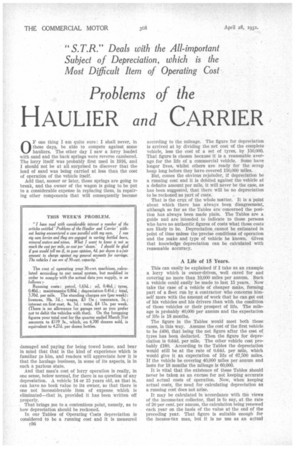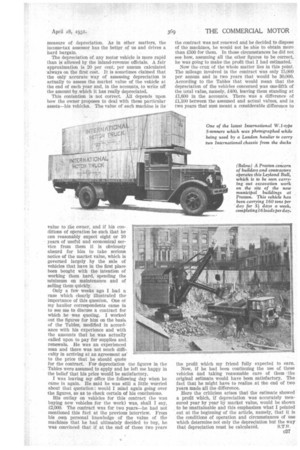Problems of the
Page 58

Page 59

If you've noticed an error in this article please click here to report it so we can fix it.
HAULIER and CARRIER 0 F one thing I am quite sure; I shall never, in these days, be able to compete against some hauliers. The other day I saw a lorry loaded with sand and the back springs were reverse cambered. The lorry itself was probably first used in 1916, and I should not be at all surprised to discover that the load of sand was being carried at less than the cast of operation of the vehicle itself.
Add that, sooner or later, those springs are going to break, and the owner of the wagon is going to be put to a considerable expense in replacing them, in repairing other components that will consequently become damaged and paying for being towed home, and bear in mind that that is the kind of experience which is familiar to him, and readers will appreciate how it is that the haulage business, in some of its aspects, is in such a parlous state.
And that man's cost of lorry operation is really, in one sense, below normal, for there is no question of any depreciation. A vehicle 14 or 15 years old, as that is, can have no book value to its owner, so that there is one not inconsiderable item of expense which is eliminated—that is, provided it has been written off properly.
That brings me to a contentious point, namely, as to how depreciation should be reckoned.
In our Tables of Operating Costs depreciation is considered to be a running cost and it is measured c36
according to the mileage. The figure for depreciation is arrived at by dividing the net cost of the complete vehicle, less the cost of a set of tyres, by 150,000. That figure is chosen because it is a reasonable average for the life of a commercial vehicle. Some have longer lives, whilst others are ready for the scrap heap long before they have covered 150,000 miles.
But, comes the obvious rejoinder, If depreciation be a running cost and it is debited against the vehicle at a definite amount per mile, it will never be the case, as has been suggested, that there will be no depreciation to be reckoned as part of costs.
That is the crux of the whole matter. It is a mint about which there has always been disagreement, although so far as the Tables are concerned the position has always been made plain. The Tables are a guide and are intended to indicate to those persons who have no authentic figures of costs what those costs are likely to be. Depreciation cannot be estimated in point of time -unless the precise conditions of operation and the make and type of vehicle be known. Given that knowledge depreciation can be calculated with reasonable accuracy.
A Life of 15 Years.
This can easily he explained if I take as an example a lorry which is owner-driven, well cared for and covering no more than 10,000 miles per annum. Such a vehicle could easily be made to last 15 years. Now take the case of a vehicle of cheaper make, forming part of a fleet run by a contractor who concerns himself more with the amount of work that he can get out of his vehicles and his drivers than with the condition of those vehicles or their prospect of life. The mileage is probably 40,000 per annum and the expectation of life is 18 months.
The figure in the Tables would meet both those cases, in this way. Assume the cost of the first vehicle to be f 400, that being the net figure after the cost of tyres has been deducted. Then the figure for depreciation is 0.64d. per mile. The other vehicle cost probably £180. According to the Tables the depreciation would still be at the rate of 0.64d. per mile, which would give it an expectation of life of 67,500 miles. If the vehicle be covering 40,000 miles per annum and lasts for 18 months the mileage is 60,000.
It is vital that the existence of these Tables should never be taken as an excuse for not keeping accurate and actual costs of operation. Now, when keeping actual costs, the need for calculating depreciation as a running cost does not arise.
It may be calculated in accordance with the views of the income-tax collector, that is to say, at the rate of 20 per cent, per annum, the calculation being renewed each year on the basis of the value at the end of the preceding year. That figure is suitable enough for the income-tax man, but it is no use as an actual measure of depreciation. As in other matters, the income-tax assessor has the better of us and drives a hard bargain.
The depreciation of any motor vehicle is more rapid than is allowed by the inland-revenue officials. A fair approximation is 20 per cent. per annum calculated -always on the first cost. It is sometimes claimed that the only accurate way of assessing depreciation is actually to assess the market value of the vehicle at the end of each year and, in the accounts, to write off the amount by which it has really depreciated.
This contention is not correct. All depends upon how the owner proposes to deal with these particular assets—his vehicles. The value of each machine is its value to the owner, and if his conditions of operation be such that he can reasonably expect eight or 10 years of useful and economical service from them it is obviously absurd for him to take serious notice of the market value, which is governed largely by the sale of vehicles that have in the first place been bought with the intention of working them hard, spending the minimum on maintenance and of selling them quickly.
Only a few weeks ago I had a case which clearly illustrated the importance of this question. One ot my haulier correspondents came in to see me to discuss a contract for which he was quoting. I worked out the figures for him on the basis of the Tables, modified in accordance with his experience and with the amounts that he was actually called upon to pay for supplies and renewals. He was an experienced man and there was not much difficulty in arriving at an agreement as to the price that he should quote for the contract. For depreciation the figures in the Tables were assumed to apply and he left me happy in the belief that his price would be satisfactory.
I was leaving my office the following day when he came in again. He said he was still a little worried about that quotation: would I mind again going over the figures, so as to check certain of his conclusions.
His outlay on vehicles for this contract (he was buying new vehicles for the work) was, shall I say, £2,000. The contract was for two years—he had not mentioned this fact at the previous interview. From his own personal knowledge of the value of the machines that he had ultimately decided to buy, he was convinced that if at the end of those two years the contract was not renewed and he decided to dispose of the machines, he would not be able to obtain more than £500 for them. In those circumstances he did not see how, assuming all the other figures to be correct, he was going to make the profit that I had estimated.
Now the crux of the whole matter lies in this point. The mileage involved in the contract was only 15,000 per annum and in two years that would be 30,000. According to the Tables that would mean that the depreciation of the vehicles concerned was one-fifth of the total value, namely, £400, leaving them standing at £1,600 in the accounts. There was a difference of £1,100 between the assumed and actual values, and in two years that sum meant a considerable difference to the profit which my friend fully expected to earn.
Now, if he had been continuing the use of these vehicles and taking reasonable care of them the original estimate would have been satisfactory. The fact that he might have to realize at the end of two years made all the difference. Here the criticism arises that the estimate showed a profit which, if depreciation was accurately measured year by year 13-y market value, would be shown to be unattainable and this emphasizes what I pointed out at the beginning of the article, namely, that it is the conditions of operation and circumstances of use which determine not only the depreciation but the way that depreciation must be calculated.












































































































